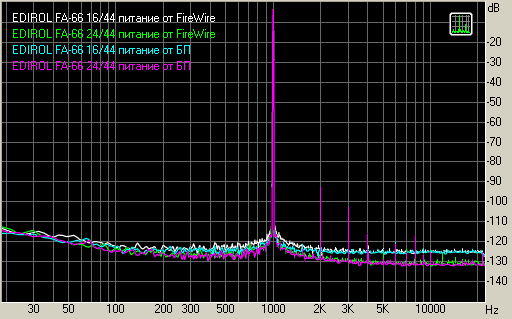 |
||
|
||
| ||
Our readers' interest in external devices has grown of late. It has to do with a number of reasons. Many users bought modern high-performance notebooks or computers of a compact form factor (barebone), which can hardly accommodate a usual sound card. Manufacturers also significantly expanded the range of their USB and FireWire products. Besides, many users believe in an advantage of external devices over internal ones. This belief is based on the wrong idea of modern PCI cards, based on impressions from gaming and semiprofessional 7-year old sound cards with lousy AC'97 and budget I2S codecs. There is also a problem with the lack of objective information on quality of internal as well as external devices. In our ProAudio section we'll try to fill the information vacuum and shatter the existing myths. In this article we shall review an external device - Edirol FA-66 FireWire Audio Capture.  The device is made in the form of a miniature external module in a metal case. A peculiar feature of this product - nearly all settings are adjusted with physical knobs and switches. The only software-level control is a buffer size, which is specified only once, if necessary. The other feature is a hardware analog limiter.  Thus you don't have to open a control panel over your audio program. All controls are on the device at hand. Moreover, FA-66 can be used autonomously, for example, as a mic preamp or a tiny mixer. You can also choose a power supply - FireWire bus or a PSU. The top cover of the device shows a signal routing flowchart for your information. It should also facilitate wiring. And now what concerns drawbacks. Sampling frequency is specified manually. In order to play back a file with a different sampling frequency, you should turn the device off, change the frequency, and then turn it on. When the device is re-initializing (10-60 seconds), audio applications running on our rather powerful testbeds - a desktop and a notebook - would drastically slow down. Another disadvantage - no indication of signal levels.


Speaking of converters, it should be noted that a device of this price segment should have had a more advanced ADC; at least no worse than in $150 sound cards. RMAA 5.5.2 TestsASIO Diagnostics (RM3DSound 2.2) Device: EDIROL FA-66 Features: Remember that only one sampling frequency mode works at a time. When you switch to another mode, you have to reboot the device. There are six inputs and outputs both for MME/WDM and ASIO, which can be used for recording and playback. RMAA 5.5.2 TestsTested chain: Edirol FA-66 Line-Out -> LynxTwo Line-In Mode: 16 bit 44 kHz
Detailed report on tests in 44 kHz mode  When we tested the device with Lynx, we registered a little LF-interference due to a ground loop. We tried to test Edirol connected to a notebook. The problem grew smaller, but it did not disappear. We had no ground problems in loopback mode, but the results were limited by the ADC quality. We decided to publish both measurements. In case of Lynx, Edirol practically reached the specification parameters in 24 bit mode: 106 dB versus 108 dB maximum for output. Measurements in loopback modeMode: 16 bit 44 kHz
Detailed report on tests in 44 kHz mode 


Subjective testsNo doubt, users are most concerned about the recording and playback quality of a device compared to other similar devices. We had an opportunity to compare Edirol FA-66 with an external MOTU Traveler and ESI Juli@ card. Comparative tests were carried out in an anechoic chamber with ADAM S2.5A near-field monitors. The monitors were connected directly to the devices without a mixer, in order to eliminate the effect of the mixer on the results. Audio qualityThe left channel of Edirol FA-66 is noticeably quieter than the right one. But it may be a bug of this very device. Unfortunately, FA-66 has no separate volume control for each channel individually. Edirol FA-66 is inferior to MOTU Traveler as well as ESI Juli@ in audio quality. Audio playback differences are in detailing and transparency. A device with higher-quality audio output clearly demonstrates reverberation and its coloring. MOTU Traveler sounds a tad better than FA-66. But higher-quality audio is demonstrated by ESI Juli@, it makes more difference. When played back by Juli@, many recording details become more distinct. Recording qualityWe used the Nady SCM 1000 studio condenser microphone in our record quality tests. We recorded vocal and a trumpet (brass). One and the same phrase was played for correct comparison. Contrary to our fears that we wouldn't make out the difference, these devices demonstrated obvious differences. A recording made by ESI Juli@ via Behringer Eurorack MX 602A turned out of a much higher quality. It was especially noticeable in trumpet recordings. Recordings made with FA-66 and Traveler had poor high frequencies and sounded flat. Note that an input signal in Edirol FA-66 and MOTU Traveler is limited to -6 dB. We couldn't find out the reasons. Both Traveler and FA-66 FireWire devices record in a similar way. But MOTU Traveler recordings offer much better high frequencies. We also tested the Edirol FA-66 hardware limiter. In our opinion, it offers no improvements. It adds some crackling. You'd better not use it, just do not allow the signal to reach clipping.
Edirol FA-66 is kindly provided by the representative office of Roland in Russia MOTU Traveller Firewire interface, Nady SCM 1000 studio condenser microphone and ADAM S2.5A monitors are kindly provided by PROAUDIO.RU Grigory Liadov (grigory@ixbt.com) December 12, 2005 Write a comment below. No registration needed!
|
Platform · Video · Multimedia · Mobile · Other || About us & Privacy policy · Twitter · Facebook Copyright © Byrds Research & Publishing, Ltd., 1997–2011. All rights reserved. |